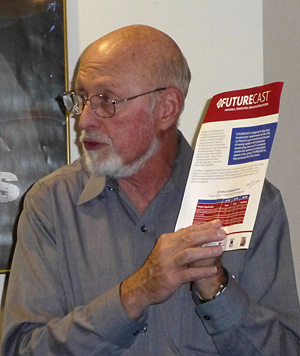Summary of Field Test Results from Futurecast OTA Demonstration

Wayne Luplow, Zenith vice president
Editor’s note: This document was provided by LG/Zenith's Wayne Luplow to give some information on field testing that occurred during two over-the-air tests of a candidate ATSC 3.0 transmission system. The most recent test, conducted on Oct. 22, 2014, included distant reception in challenging terrain, some of which is discussed below.
MADISON, WIS. — LG Electronics, Zenith and GatesAir worked with Quincy Group’s WKOW-TV in Madison, Wis., on the first field tests of the proposed ATSC 3.0 physical layer system called “Futurecast,” beginning in August 2014.
The purpose of initial testing was a “shakedown cruise” for hardware and comparative tests of the Futurecast physical layer versus the existing “ATSC 1.0” VSB technology. Because the Futurecast signal is very different from ATSC 1.0, WKOW’s ATSC signal had to be turned off and substituted with the new signal. This could only be done in early morning hours, in order to minimize interruption of WKOW’s normal broadcast programs.
The dual nature of these tests, as both system evaluation and hardware debugging, was critically important. The August results pointed both to some hardware bugs and to some signal parameter adjustments, knowledge of which gave us the confidence to do a public status report via a live physical demonstration during second round testing in October. The October work consisted of a repeat measurement of many test locations from August, evaluation of some system adjustments and demonstrations for expert viewers at particular sites.
The August and October Futurecast field tests verified clear improvements in both data rate and robustness (relative to ATSC 1.0, including its Mobile DTV mode).
This data is particularly useful as we continue to improve the hardware implementation and gain experience in parameter choices for different use cases. We are committed to support ATSC 3.0 development through the whole process to a complete system.
The professional video industry's #1 source for news, trends and product and tech information. Sign up below.
Key Findings from the Field Test:
Prototype transmitter and receiver hardware in FPGA realization form for debugging and error reporting requirements.
Three transmission modes (Data Pipes: Dp0, Dp1, Dp2) simultaneously in a single channel:
Dp0: A high capacity mode, demonstrated with carriage of a 4K Ultra HD program;
·30 percent capacity improvement over ATSC 1.0
Dp1: Simultaneously, a 720P HDTV program carried in a robust mode receivable by mobile devices.
·Matches the threshold of the most robust mode of the existing ATSC MDTV system
·Has 2.5 times the ATSC MDTV payload at the same threshold and bandwidth
Dp2: Also simultaneously, an even more-robust signal suitable for handheld devices and deep indoor locations.
·Trades off some data rate for even greater penetration into difficult locations
Testing confirmed that a wide variety of mode choices are available to meet broadcasters’ needs for a flexible system.
Results of Tests performed at 12 fixed locations and 7 indoor locations:
·Generally, good VSB and Dp0 reception at the door, but not inside
·MDTV and Dp2 (most robust) indoor reception possible as far as AC and antenna cables allowed
·Dp2 showed significant robustness over ATSC MDTV
Results of Tests performed during 14 mobile route segments:
·Test routes intentionally went beyond expected coverage area
o53 miles southwest of the transmitter
o40 miles northwest, past high ridge area
·Approximately 16,500 collected data points for each mode: nearly 50,000 total data points
·Mobile reception of Dp0 mode was poor (not unexpected)
·Total clean mobile reception data points of Dp1 were slightly less than those of ATSC MDTV
·Mobile reception of Dp2 also showed impressive results
·RF recordings were made to assist receiver improvements
LG Electronics, Zenith and Gates Air continue to work on the Futurecast system and prototype hardware, and we look forward to providing future progress updates and proofs of performance.
